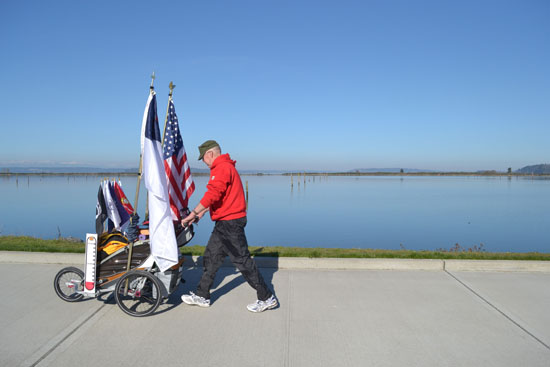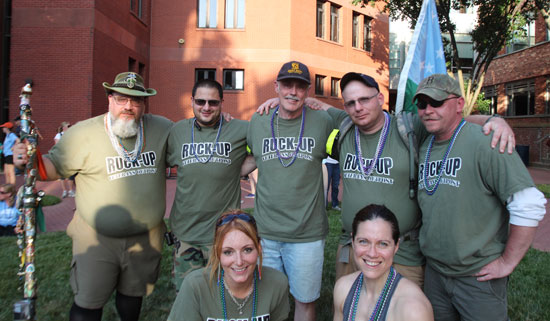By Meg Wagner, News21

Chuck Lewis sets out on his first day of a cross-country walk in Everett, Wash. (Photo submitted by Linda Sappington)
Retiree Chuck Lewis considered two ways to spend six months: sitting at home or walking across the country. He chose the latter.
The 62-year-old U.S. Marine Corps and Navy veteran is “Walking for the Fallen,” a cross-country trek raising money for wounded veterans. His 3,300-mile journey began March 31 in Everett, Wash., and is scheduled to end sometime in September at the Vietnam Veterans Memorial in Washington, D.C.
A few years ago at Christmas, Lewis stood in uniform on a street corner in his Ronan, Mont., hometown and held a sign that read, “Standing here today in respect of those away.”
He made it a holiday ritual, and passersby started giving him money – 50 cents, $50, whatever they could. When he collected $1,000, he donated it to non-profits that help wounded veterans and their families.
Soon, Montana wasn’t big enough.
“We were sitting on the couch having our coffee like we do every day – like we did every day before he left,” said Linda Sappington, Lewis’ wife. “And he said ‘I’ve done everything I want to accomplish in Montana. Why don’t I walk across America?’”
Sappington was supportive from the start.
“We’ve been married for 20 years, so I know the guy’s a wild man,” she said. “When he has an idea, he has no problem making it happen.”
Lewis walks about 25 miles a day, pushing a two-child stroller that carries essentials: a tent, a sleeping bag, freeze-dried food and a solar panel to charge his phone, among other basics.
Some nights he camps. On others he sleeps in churches or in firehouses. Sometimes, people who’ve learned of his journey offer him a bed and laundry use.
His goal is $50,000. So far, he’s raised $14,100 as of June 12, Lewis said.
He raises awareness, too. Lewis walks in honor of those overseas and in remembrance of those who’ve died.
“Six months is a drop in the bucket when you compare it to the soldiers who never come home,” he said.



